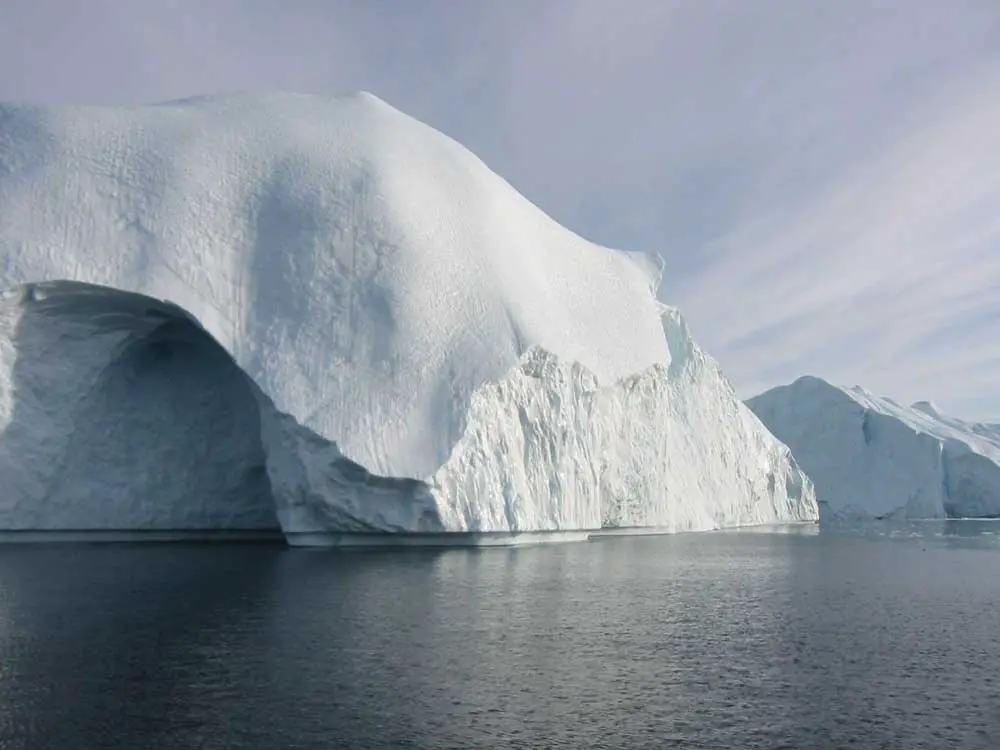
By Alun Hubbard
I’m standing at the edge of the Greenland ice sheet, mesmerized by a mind-blowing scene of natural destruction. A milewide section of glacier front has fractured and is collapsing into the ocean, calving an immense iceberg.
Seracs, giant columns of ice the height of three-story houses, are being tossed around like dice. And the previously submerged portion of this immense block of glacier ice just breached the ocean – a frothing maelstrom flinging ice cubes of several tons high into the air. The resulting tsunami inundates all in its path as it radiates from the glacier’s calving front.
Fortunately, I’m watching from a clifftop a couple of miles away. But even here, I can feel the seismic shocks through the ground.
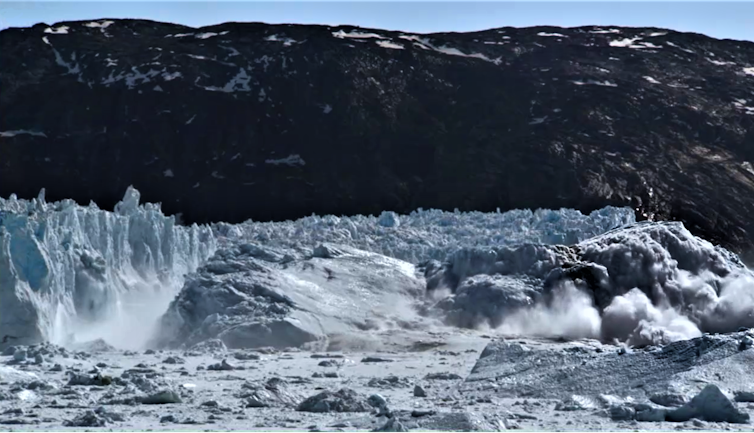
Alun Hubbard
Despite the spectacle, I’m keenly aware that this spells yet more unwelcome news for the world’s low-lying coastlines.
As a field glaciologist, I’ve worked on ice sheets for more than 30 years. In that time, I have witnessed some gobsmacking changes. The past few years in particular have been unnerving for the sheer rate and magnitude of change underway. My revered textbooks taught me that ice sheets respond over millennial time scales, but that’s not what we’re seeing today.
A study published Aug. 29, 2022, demonstrates – for the first time – that Greenland’s ice sheet is now so out of balance with prevailing Arctic climate that it no longer can sustain its current size. It is irreversibly committed to retreat by at least 59,000 square kilometers (22,780 square miles), an area considerably larger than Denmark, Greenland’s protectorate state.
Even if all the greenhouse gas emissions driving global warming ceased today, we find that Greenland’s ice loss under current temperatures will raise global sea level by at least 10.8 inches (27.4 centimeters). That’s more than current models forecast, and it’s a highly conservative estimate. If every year were like 2012, when Greenland experienced a heat wave, that irreversible commitment to sea level rise would triple. That’s an ominous portent given that these are climate conditions we have already seen, not a hypothetical future scenario.
Our study takes a completely new approach – it is based on observations and glaciological theory rather than sophisticated numerical models. The current generation of coupled climate and ice sheet models used to forecast future sea level rise fail to capture the emerging processes that we see amplifying Greenland’s ice loss.
How Greenland got to this point
The Greenland ice sheet is a massive, frozen reservoir that resembles an inverted pudding bowl. The ice is in constant flux, flowing from the interior – where it is over 1.9 miles (3 kilometers) thick, cold and snowy – to its edges, where the ice melts or calves bergs.
In all, the ice sheet locks up enough fresh water to raise global sea level by 24 feet (7.4 meters).
Greenland’s terrestrial ice has existed for about 2.6 million years and has expanded and contracted with two dozen or so “ice age” cycles lasting 70,000 or 100,000 years, punctuated by around 10,000-year warm interglacials. Each glacial is driven by shifts in Earth’s orbit that modulate how much solar radiation reaches the Earth’s surface. These variations are then reinforced by snow reflectivity, or albedo; atmospheric greenhouse gases; and ocean circulation that redistributes that heat around the planet.
We are currently enjoying an interglacial period – the Holocene. For the past 6,000 years Greenland, like the rest of the planet, has benefited from a mild and stable climate with an ice sheet in equilibrium – until recently. Since 1990, as the atmosphere and ocean have warmed under rapidly increasing greenhouse gas emissions, Greenland’s mass balance has gone into the red. Ice losses due to enhanced melt, rain, ice flow and calving now far exceed the net gain from snow accumulation.
What does the future hold?
The critical questions are, how fast is Greenland losing its ice, and what does it mean for future sea level rise?
Greenland’s ice loss has been contributing about 0.04 inches (1 millimeter) per year to global sea level rise over the past decade.
This net loss is split between surface melt and dynamic processes that accelerate outlet glacier flow and are greatly exacerbated by atmospheric and oceanic warming, respectively. Though complex in its manifestation, the concept is simple: Ice sheets don’t like warm weather or baths, and the heat is on.
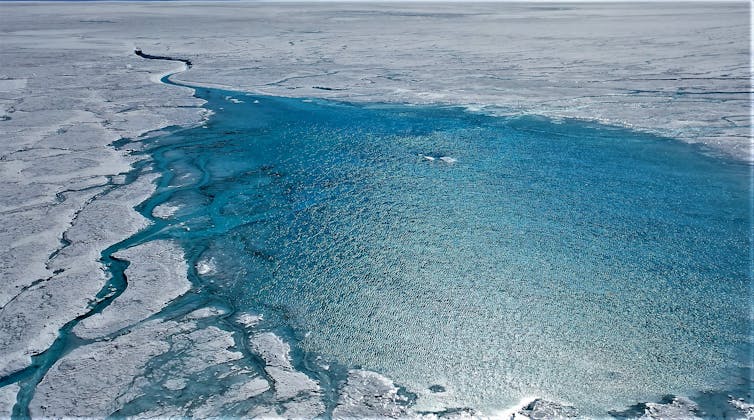
Alun Hubbard
What the future will bring is trickier to answer.
The models used by the Intergovernmental Panel on Climate Change predict a sea level rise contribution from Greenland of around 4 inches (10 centimeters) by 2100, with a worst-case scenario of 6 inches (15 centimeters).
But that prediction is at odds with what field scientists are witnessing from the ice sheet itself.
According to our findings, Greenland will lose at least 3.3% of its ice, over 100 trillion metric tons. This loss is already committed – ice that must melt and calve icebergs to reestablish Greenland’s balance with prevailing climate.
We’re observing many emerging processes that the models don’t account for that increase the ice sheet’s vulnerability. For example:
- Increased rain is accelerating surface melt and ice flow.
- Large tracts of the ice surface are undergoing bio-albedo darkening, which accelerates surface melt, as well as the impact of snow melting and refreezing at the surface. These darker surfaces absorb more solar radiation, driving yet more melt.

European Space Agency
- Warm, subtropical-originating ocean currents are intruding into Greenland’s fjords and rapidly eroding outlet glaciers, undercutting and destabilizing their calving fronts.
- Supraglacial lakes and river networks are draining into fractures and moulins, bringing with them vast quantities of latent heat. This “cryo-hydraulic warming” within and at the base of the ice sheet softens and thaws the bed, thereby accelerating interior ice flow down to the margins.
The issue with models
Part of the problem is that the models used for forecasting are mathematical abstractions that include only processes that are fully understood, quantifiable and deemed important.
Models reduce reality to a set of equations that are solved repeatedly on banks of very fast computers. Anyone into cutting-edge engineering – including me – knows the intrinsic value of models for experimentation and testing of ideas. But they are no substitute for reality and observation. It is apparent that current model forecasts of global sea level rise underestimate its actual threat over the 21st century. Developers are making constant improvements, but it’s tricky, and there’s a dawning realization that the complex models used for long-term sea level forecasting are not fit for purpose.
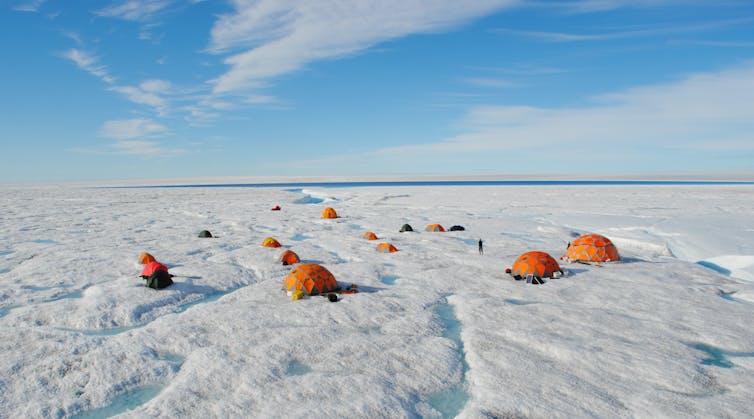
Alun Hubbard
There are also “unknown unknowns” – those processes and feedbacks that we don’t yet realize and that models can never anticipate. They can be understood only by direct observations and literally drilling into the ice.
That’s why, rather than using models, we base our study on proven glaciological theory constrained by two decades of actual measurements from weather stations, satellites and ice geophysics.
It’s not too late
It’s an understatement that the societal stakes are high, and the risk is tragically real going forward. The consequences of catastrophic coastal flooding as sea level rises are still unimaginable to the majority of the billion or so people who live in low-lying coastal zones of the planet.
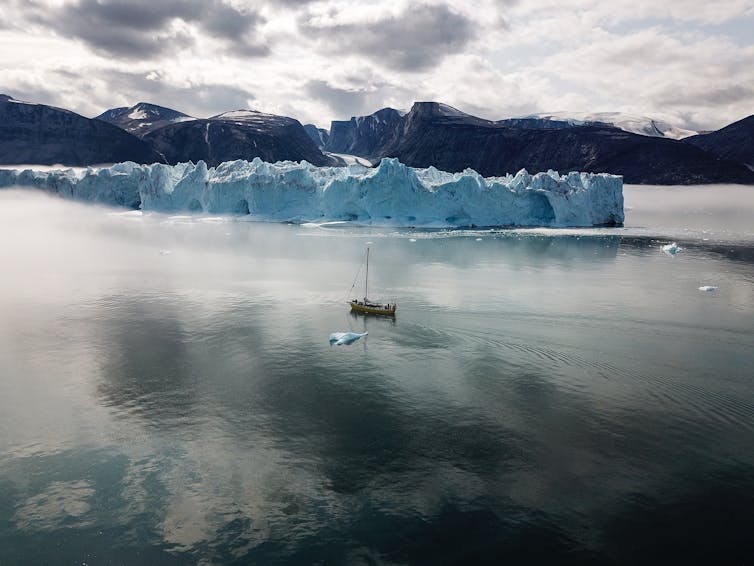
Alun Hubbard
Personally, I remain hopeful that we can get on track. I don’t believe we’ve passed any doom-laden tipping point that irreversibly floods the planet’s coastlines. Of what I understand of the ice sheet and the insight our new study brings, it’s not too late to act.
But fossil fuels and emissions must be curtailed now, because time is short and the water rises – faster than forecast.
![]()
Alun Hubbard is Professor of Glaciology, Arctic Five Chair, at the University of Tromsø, the Arctic University of Norway.





























Jimbo99 says
How could this possibly still be happening in the Biden-Harris & AOC (or any Green New Deal Liar for that matter) America of inflation to save the planet ? The EV race is a fraud, just like Covid was, self proclaimed experts lying about a better planet Earth to pad their bank accounts with no solutions to anything, even fabricating issues. The planet Earth will be just fine. Even with Flagler Beach erosion, it’s time to realize that ocean front property wasn’t worth what it’s been flipped for. I suggest the one’s on that front line of the battle, retreat and take your casualty losses, the rest of us aren’t the one’s picking up the tab on this.
ULTRA MAGAp says
Very interesting article but, it Failed to mention the Most Important Problem with trying to STOP Climate Change, CHINA and INDIA! Yes, these two countries with their Super Growth Economic Policy( which is needed to keep Xi Jinping in Power) ARE Causing Climate Change with their use (and continuing to build more) of Very Dirty Coal-Burning Power Plants! They falsely claim that are ‘developing nations’ therefore they have a ‘RIGHT’ to use Coal-Burning Power Plants! This is BULLSHIT!! All the Nations of the World Must Work Together( with the same LAWS for every nation) to Slow than STOP Climate Change! WOW! This statement is from a Very Conservative Republican who 10+ yrs ago sold the DEVELOPMENTS. RIGHTS to his Tree Farm to do his part in Slowing/Stopping Climate Change.. I wonder if any member the Flagler County Home Builders Association would do what I did ? We’ll know the answer that question! American Tree Farm System was founded in 1941 and is providing assistance to those of us who want to SAVE the Earth because it is the ONLY Earth we humans have! Please Support my Campaign for Tree Farms in Flagler County! America First! Flagler County First! Help STOP Climate Change!
Joseph Barand says
The biggest cause of Global Warming is the BS words spoken by Evangelists, Conservatives and Republicans. They are now advocating Civil War without any concerns about Russia and China waiting in the wings for us weaken ourselves to the state where they can take over the US. Trump, Graham, McConnell etc all want to live under Communist control and are doing everything possible to expedite their desire. All they have to do is to determine which they want China or Russia?
Mikem says
I think your comment is BS. China and India use more coal to generate electricity than the rest of the world combined. Get your data and facts straight. If you have ever been to China , which I seriously doubt, You cannot see your hand in front your face on a cloudless day. Beijing has a brownish haze (every day) on a scale that is unbelievable. The only good thing about China and India is that they will pollute themselves out of existence long before global warming gets them.
Dennis C Rathsam says
As long as China & India continue to build coal fired plants for electric, there is no hope for humanity. Everything we suffer through, with these high prices for everything is useless because China & India will still polute the air, the temps will rise, & the oceans will be knocking on our back door.